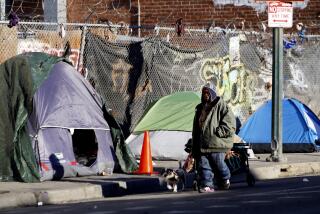O.C.’s Homeless Are in Demand on Census Night
ORANGE — The minibus arrived promptly at 6 p.m. in front of St. John’s Lutheran Church and the passengers, familiar with the shelter routine, quickly formed a line at the door.
The church’s aging gymnasium seemed vast, dotted with a dozen or so cots, the floor covered with a blue tarpaulin. But within minutes, the home of the church basketball team, choir club practice and the potluck dinner became a temporary refuge for the homeless.
The immediate concern for the 25 or so men and women was cots: Were they assigned, were there more? And blankets? And where were the showers, and when would dinner be served?
Among this disparate collection of Orange County’s street people, there was very little talk about the first-ever count of the nation’s homeless. But St. John’s opened its doors Tuesday to help census takers reach as many homeless as possible.
City and county officials have urged shelter operators and their clients to cooperate with the census, as the area’s claim to federal aid for homeless programs will depend in large measure on the number of people surveyed. Across the country, civic leaders raced Tuesday to round up homeless people, many of whom crave their anonymity, and shuttle them to areas where census workers could reach them.
“There is no way that everyone will be counted,” said Susan Oakson of the Orange County Homeless Issues Task Force. “But we know that policy decisions and funding will be based on this information, and for our community it is important to make as accurate a count as possible. What has to be understood is that this information will be just a slice.”
Across Orange County, homeless people by the hundreds came in from the darkness. Some of them complied nervously, others with unfounded fears that being uncooperative would get them arrested.
St. John’s was one of two churches that opened their doors to the homeless in conjunction with Tuesday night’s count.
Orangethorpe United Methodist Church in Fullerton was the other, and it was there that Richard Martinez, who showed up in search of a place to sleep, agreed to be counted. But he remained skeptical of the promise that his lot will improve because of his cooperation.
“It’s a political thing,” he said. “They say that there will be more money for social programs just to get us to fill it out.”
Thomas Driber, program coordinator of the Anchor House in San Clemente, said many of the homeless people with whom he spoke were wary of the census. “Some are willing to be very cooperative,” he said. “Others have the feeling: ‘Why bother? The system hasn’t done anything for me, and it’s getting worse.’ ”
Still, all the residents of Anchor House cooperated, egged on by census officials who informed them that “they had no choice,” Driber said. Although it is illegal to refuse to cooperate with census takers, such cases are rarely prosecuted.
Despite the reservations, many homeless people gathered in the lobbies, gymnasiums and corridors of shelters filling out forms that would document their homelessness.
“It is a good idea to acknowledge these people and myself, to find out what the reality is,” said Eugene Binau, 35, who has mostly slept on the concrete steps of Santa Ana Civic Center during the four months he has been homeless.
Binau, a Santa Ana native and an unemployed auto painter, said this is the first time that he has experienced living on the street. “It only takes one or two things to go wrong. Like if you can’t find a job quick enough, then you can lose it all,” he said, standing on the steps of the church.
Gezabel Burke, 28, sat with a towel wrapped around her just-washed hair at the Martha House in Orange. Burke, a student at Golden West College, became homeless after her boyfriend threatened to kill her and she sought refuge in a shelter for battered women.
“They should have asked other questions, like ‘are there drug problems in the home?’ and ‘is there alcoholism in these places?’ ”.
Contributing to this story were Len Hall, Laura Michaels, Michelle Nicolosi and Leon Teeboom.
More to Read
Sign up for Essential California
The most important California stories and recommendations in your inbox every morning.
You may occasionally receive promotional content from the Los Angeles Times.












